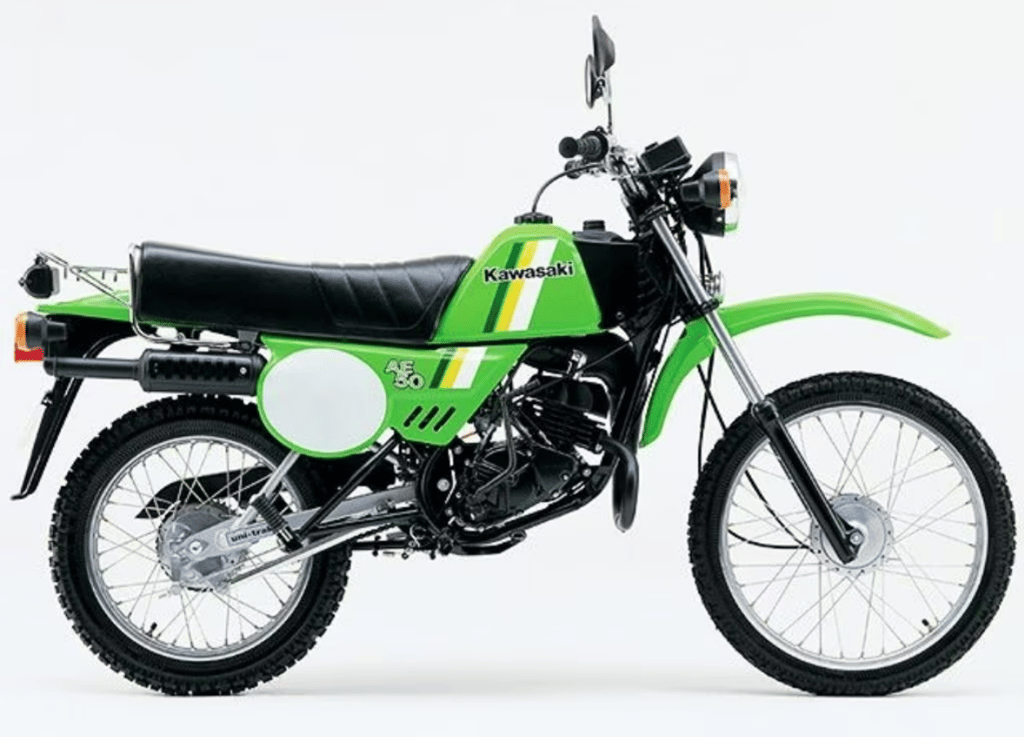The Kawasaki AE50: A Trail Bike Design for Urban Adventures
The Kawasaki AE50, a moped with a trail bike design, made its debut in the 1980s. Its upright riding position, angular headlamp, tall front fender, and spoke wheels gave it a rugged and adventurous appearance, while its reliable 49cc two-stroke engine, automatic transmission, comfortable seating, and lightweight chassis added to its practicality and rider comfort. The AE50's enduring legacy is a testament to its innovative design, combining the charm of a trail bike with the practicality of a moped.
MOTORCYCLES OFF ROAD MOPEDSJAPAN 1980'STWO STROKEKAWASAKI
11/7/20232 min read


The Kawasaki AE50: A Trail Bike Design for Urban Adventures
Introduction
In the 1980s, the Kawasaki AE50 made its debut, capturing the imagination of riders with its unique trail bike design. This compact yet stylish moped offered an upright riding position and a distinctive look that set it apart from the crowd. In this article, we will delve into the details of the Kawasaki AE50, exploring its trail bike-inspired design and its rider-friendly features.
Trail Bike Design
The Kawasaki AE50 stood out from the conventional mopeds of its time with its trail bike design. This design approach drew inspiration from off-road motorcycles, offering a more rugged and adventurous appearance. The most prominent features of this trail bike design were:
Upright Riding Position: One of the key elements of a trail bike design is the upright riding position it offers. The AE50 featured high and wide handlebars that allowed riders to sit upright, providing a commanding view of the road ahead. This riding position not only contributed to rider comfort but also improved maneuverability, making it well-suited for urban environments.
Angular Headlamp: The moped's angular headlamp design added a touch of sportiness to its appearance. This distinctive headlamp shape was reminiscent of off-road and motocross motorcycles, reinforcing the trail bike-inspired look.
Tall Front Fender: The AE50's tall front fender contributed to its rugged appearance while serving a practical purpose by providing protection from mud and debris.
Spoke Wheels: Spoke wheels added to the moped's overall design, further emphasizing its off-road aesthetics.
While the Kawasaki AE50 embraced a trail bike design, it did not compromise on practicality and rider comfort:
Reliable 49cc Two-Stroke Engine: The AE50 was equipped with a dependable 49cc two-stroke engine that provided sufficient power for city commuting. This engine was known for its low fuel consumption and ease of maintenance.
Automatic Transmission: To cater to a wide range of riders, the AE50 featured an automatic transmission, making it accessible to beginners while ensuring a hassle-free riding experience.
Comfortable Seating: The moped's spacious and comfortable seat accommodated both the rider and a passenger, making it a practical choice for daily commuting and short trips.
Lightweight Chassis: The lightweight chassis enhanced maneuverability and agility, enabling riders to navigate through city traffic with ease.
Enduring Legacy
The Kawasaki AE50's enduring legacy is a testament to its innovative design, combining the rugged charm of a trail bike with the practicality of a moped. Enthusiasts and collectors continue to appreciate its unique blend of style, comfort, and simplicity. The upright riding position and trail bike aesthetics have left an indelible mark in the history of mopeds and continue to evoke a sense of nostalgia among those who experienced its golden era.
Conclusion
The Kawasaki AE50's trail bike design, upright riding position, and distinctive appearance made it a standout choice in the world of mopeds. Its enduring popularity reflects its ability to seamlessly blend style with practicality. The AE50 remains a beloved classic, reminding us of a time when adventure met urban commuting in a single, iconic package.
